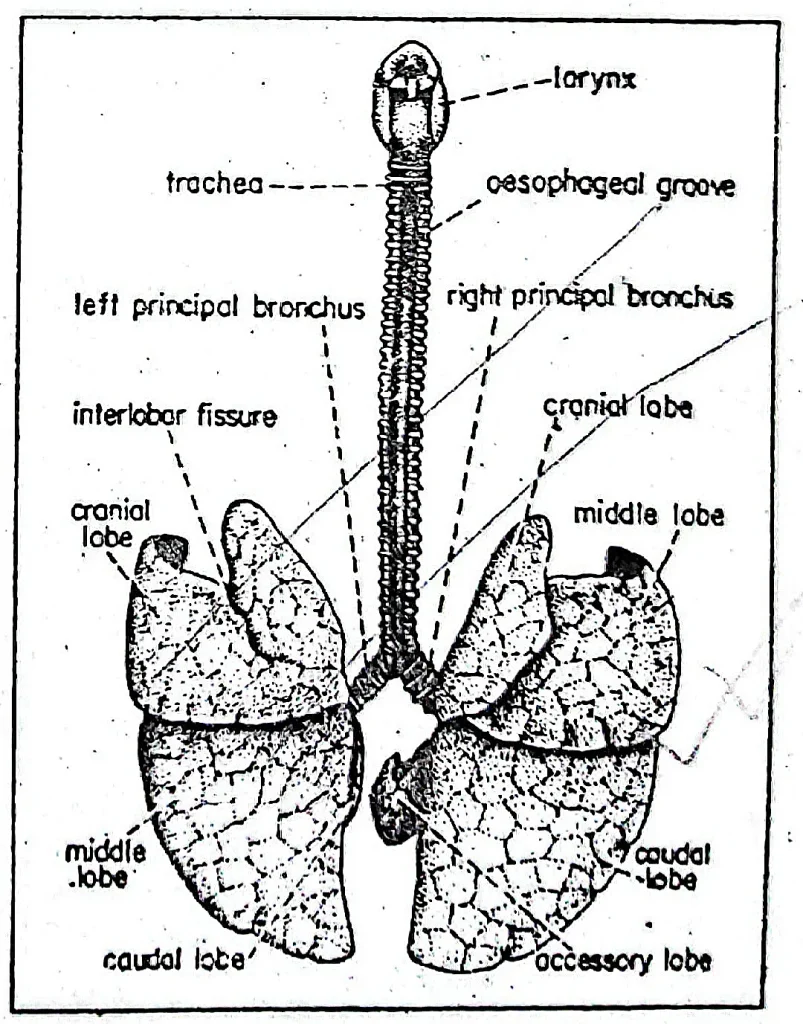In this article about Guinea pig or Cavia porcellus, we will learn about the respiratory system of Cavia. Cavia porcellus is the scientific name of the Guinea pig.
Respiratory System of Guinea Pig
- Respiration is aerial. That means it takes oxygen from the air.
- The gaseous exchange takes place in the lungs.
- The respiratory system of Cavia consists of a long respiratory tract and there are different regions in the tract.
The following are the different regions of the respiratory tract of Cavia.

fig: Respiratory system of Cavia (Dorsal view)
1. External Nares
- A pair of external nares are present.
- They are present at the tip of the snout, above the mouth.
- Air enters through these openings.
2. Nasal Cavities
- A pair of nasal cavities are present.
- External nares open into the nasal cavities.
- Both nasal cavities are separated from each other by a nasal septum.
3. Internal Nares
- A pair of internal nares are present.
- Nasal cavities open internally through these internal nares.
4. Naso-Pharynx
- The internal nares are open here.
- The pharynx is divided into two regions; the dorsal and the ventral region. Naso-pharynx is the dorsal part of the pharynx.
5. Glottis
- It is an aperture present on the floor of the bucco-pharynx. Bucco-pharynx is the ventral portion of the pharynx.
- The glottis is guarded by the epiglottis.
- Epiglottis is a cartilaginous flap.
6. Larynx
- It is a chamber formed by four cartilages.
- The cartilages are: one thyroid cartilage, two arytenoid cartilage, and one cricoid cartilage.
- The thyroid cartilage forms the ventral and lateral sides of the larynx.
- The arytenoid cartilages are small and they form the dorsal wall of the larynx.
- The cricoid cartilage is circular and forms the posterior part of the larynx.
- The larynx bears a pair of vocal cords. The vocal cords are the elastic bands.
- These vocal cords help the Cavia to produce sounds.
7. Trachea
- It is a long tube.
- The larynx opens into the trachea.
- The trachea runs through the neck.
- It is encircled by a series of 35-40 cartilaginous rings.
- The rings are incomplete at the dorsal side.
8. Bronchus
- The trachea, after entering the thorax, is divided into two, the right and left bronchi.
- Both right and left bronchi enter into the lung of the corresponding side.
- After entering the lungs, the bronchi divide into bronchioles.
9. Lungs
- There are two lungs present in the Cavia; the left lung and the right lung.
- The lungs are located in the thorax cavity.
- They are spongy and elastic.
- A two-layered pleural sheath encloses the lungs. The outer layer of the pleural sheath is the parietal pleura and the inner layer is called the visceral pleura.
- The left lung is three-lobed and the right lung is four-lobed.
- The three lobes of the left lung are the cranial, middle, and caudal lobes.
- The four lobes of the right lung are the cranial, middle, caudal, and accessory lobes.
- The right lung is larger than the left lung.
- The bronchioles, in the lungs, break up and form alveolar ducts.
- The wall of the alveolar ducts forms alveolus.
- The pulmonary blood vessels form network on the wall of the alveoli.
Mechanism of Respiration
Inspiration
- During inspiration, the intercostal muscles contract to raise the ribs and that’s why the thoracic cavity increases.
- The diaphragm allows to increase the chest cavity.
- The lungs expand as the thoracic cavity increases.
- After expanding the lungs, the air enters into the lungs through the respiratory tract.
Expiration
- During expiration, the retraction of intercostal muscles occurs.
- As the intercostal muscles retract, the diaphragm brings the thoracic cage back to its normal state.
- As the thoracic cage comes back to its normal state, the lungs get pressure.
- Because of the pressure, the air from the lungs comes to the outside.
——————-THE END——————
Read More:
- Circulatory System of Guinea pig | Cavia porcellus | Diagram
- Nervous System of Guinea Pig | Cavia porcellus | Diagram
- Digestive System of Guinea Pig | Cavia porcellus | Diagram
- External Morphology of Guinea Pig | Cavia porcellus | Diagram
- General Characters of All Classes of Vertebrates.
Reference:

Md Ekram Hossain Bhuiyan is a passionate student currently pursuing his studies at Jagannath University in Dhaka. He is a zoology major and his love for animals, nature, and wildlife is evident in his academic pursuits. Ekram is a curious and adventurous individual who always seeks to learn more about the world around him. His passion for animals began at a young age, and he has since dedicated himself to studying the behavior, anatomy, and habitats of various species.
He finds peace in being surrounded by the beauty of nature and observing the creatures that call it home. He believes that it is important to protect and preserve the natural world for future generations.
As a student of zoology, Ekram is dedicated to expanding his knowledge of the subject. He is a hardworking individual who strives for excellence in his studies and is always eager to take on new challenges. Ekram is a driven and compassionate individual who is dedicated to his studies and his passion for animals, nature, and wildlife.